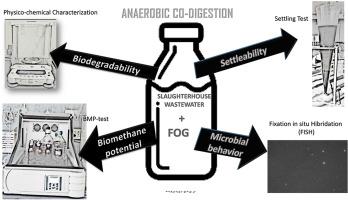Chemosphere ( IF 8.1 ) Pub Date : 2020-06-23 , DOI: 10.1016/j.chemosphere.2020.127474 Cristina Agabo-García 1 , Rosario Solera 1 , Montserrat Pérez 1

|
Anaerobic digestion (AD) is the biological preferred treatment applied to Slaughterhouse wastewaters (SWW) due to its effectiveness. The aim of the study is to investigate the effect of different percentages of fats, oil and grease (FOG) on biomethane production in anaerobic co-digestion with slaughterhouse wastewater using BMP tests under mesophilic conditions (35 °C). For this purpose, three percentages of FOG from 1% to 10% were tested. Biodegradability, biomethane production and the microbial population were studied. In addition, settling capacity has been evaluated at different conditions: i) before and after anaerobic co-digestion; ii) at different temperature 25 °C and 35 °C. The settling rates as well as the characterization of the digestate were recorded. Experimental results showed that all the co-digestion mixtures (FOG percentages = 1–10%) enhanced biomethane production and biodegradability compared to AD of sole SWW. The best conditions were achieved at 5–10% of FOG, showing biodegradability of 66–70% CODtremoval and specific biomethane productions of 562 and 777 mLCH4·g−1CODsremoved, respectively. Regarding microbial dynamics, Eubacteria was reduced with the increase in %FOG but Acetate utilizing methanogens was increased. Regarding settling capacity, mesophilic temperatures (35 °C) increased the settling rate of digestate in 1.76 times and reduced the lag-phase to 0.92 min; obtaining a more concentrated sludge and leaving a clarified whose TSS represent only 8% of TS.
中文翻译:

用作与屠宰场废水厌氧共底物的脂肪,油脂(FOG)的第一种方法:生物甲烷潜力,沉降能力和微生物动力学。
由于其有效性,厌氧消化(AD)是应用于屠宰场废水(SWW)的生物首选处理方法。这项研究的目的是在中温条件下(35°C)使用BMP试验研究不同百分比的油脂,脂肪(FOG)对厌氧消化与屠宰场废水中生物甲烷产生的影响。为此,测试了从1%到10%的FOG的三个百分比。研究了生物降解性,生物甲烷的产生和微生物种群。此外,在不同条件下评估了沉降能力:i)厌氧消化之前和之后;ii)在25°C和35°C的不同温度下。记录沉降速率以及消化物的特征。实验结果表明,与单独的SWW的AD相比,所有共消化混合物(FOG百分比= 1–10%)均提高了生物甲烷的产生和生物降解能力。FOG的5-10%达到了最佳条件,显示出66-70%CODt的可生物降解性分别去除了562和777 mL CH4 ·g -1 COD的脱除率和特定的生物甲烷气产量。关于微生物动力学,随着%FOG的增加,真细菌减少,但利用产甲烷菌的乙酸盐增加。关于沉降能力,中温温度(35°C)使消化液的沉降速度提高了1.76倍,并将滞后相降低至0.92分钟;获得更浓缩的污泥,并留下澄清剂,其TSS仅占TS的8%。











































 京公网安备 11010802027423号
京公网安备 11010802027423号